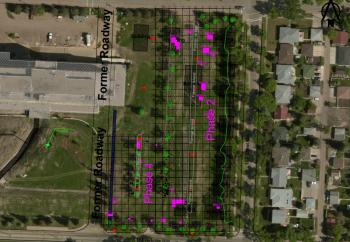Image Caption
Summary
Local Journalism Initiative Reporter
Windspeaker.com
As work to uncover 21 anomalies on the grounds of the west portion of the former Charles Camsell Indian Hospital gets underway tomorrow, Papaschase First Nation Chief Calvin Bruneau finds himself in a difficult position.
“There’s a hope to actually locate the graves, for one, and hope to bring closure to families. But the thing is, that’s going to be difficult in itself because you don’t know who’s buried there or potentially buried there. At least if we can find human remains there then you know, first of all, the people’s stories were true, and then that … brings further scrutiny to what happened at the Charles Camsell,” said Bruneau.
The Edmonton hospital has a sordid past. It became the Indian Hospital in 1945, jointly run by the Royal Canadian Army Medical Corps and Indian Health Services until 1979. It served primarily as a tuberculosis sanatorium, bringing in Indigenous patients from the western provinces, the western Arctic and the sub-Arctic.
There are many stories by former patients and relatives of mistreatment of, and experimentation on, Indigenous people, some of which have been documented in books. There are also stories of people dying and being buried on the grounds.
The site is now under development by architect Gene Dub’s company Five Oaks Inc. The overall project involves the hospital being converted into housing; 20 townhouses built to the north of the hospital and a seniors project to the south. Land to the west has been zoned for an apartment, but there are no plans at this time to build that apartment.
A first set of 11 anomalies identified through ground penetrating radar (GPR) in the parking lot were found to be only concrete and steel debris and old tree roots.
However, this set of 21 anomalies, or regions of interest (ROI), also identified through GPR, could have a different outcome. They are located on two acres west of the hospital which runs from the southeast to northeast along 127th Street extending from 114 Avenue to 115 Avenue.
In an email that included Bruneau, Dub noted the locations could be “possible burial sites.”
“This is an area of prime concern for me,” said Bruneau. “I’ve always been told and I’ve been hearing over the years it was in the southeast corner where these possible burials are … so that’s going to be an area where we’re definitely going to need to watch.”
Bruneau is particularly concerned about a “cluster” of about 13 ROIs. The rest are scattered throughout the two or so acres that were scanned.
However, he’s also quick to point out that any burials that may have taken place on the grounds would not have been handled the same way they are in cemeteries, planned out and in precise rows.
“They were haphazardly burying people there. They’re just going to find a spot and bury them,” said Bruneau, who adds that people who died in the hospital were also buried at the Poundmaker residential school grounds (now Poundmaker Lodge near St. Albert) and Winterburn (on Enoch Cree Nation).
The plan is to carefully excavate all 21 sites. Dub anticipates the work can be done in a single day unless burials are found, and then “everything stops… We have to try and protect the site.”
“I would call for a stoppage … if human remains are found. You’ve got to make some decisions then. You’ve got to decide if you’re going to continue on,” said Bruneau, noting that if human remains are found in one site, the potential is strong they will be found in other sites as well.
Bruneau says the Edmonton police would be notified along with medical examiner and coroner.
The investigative work undertaken on the Charles Camsell grounds will cost Dub $250,000. He’s not eligible for federal funds because Charles Camsell is a former hospital and not a residential school.
“I think it’s important. I think a lot of families who had relatives in the hospital and never came back would like to know that they’re either on the site or they’re not on the site. We’re just trying to truthfully identify whether something is here or not. I think it’s quite important,” said Dub.
While Dub can’t access federal dollars, Bruneau is going to push for that funding if unmarked graves are found on the Charles Camsell grounds as meetings and gatherings and a decision-making process will need to be undertaken by the three treaty areas impacted.
“The government needs to start paying for this. They have a fiduciary duty,” said Bruneau.
Dub says he’s heard “informally” that the Inuit would prefer to leave burials at the site and acknowledge them.
Dub has already committed to a commemorative identification for those impacted by the Charles Camsell.
He adds that if graves are found on this site, he will not develop those acres. The plan had been to turn that area into single family lots. Not developing will mean a financial loss for his company.
A ceremony on site Oct.21 will be led by Papaschase First Nation Elder Fernie Marty to begin “this very sacred work… in a respectful way,” said Bruneau. Elders and representatives from other First Nations will also be in attendance. There will also be monitors from Treaty 6 and Treaty 8 overseeing the excavation work.
Bruneau says there has been a call for GPR to be done on the other two possible burial sites connected with the Charles Camsell, but the federal government has refused to provide resources.
That decision has Travis Gladue-Beauregard, whose grandfather never came home from the Charles Camsell, upset.
“The federal government is not providing assistance due to the fact that the hospital is not connected to residential schools,” Gladue-Beauregard told Windspeaker.com in an email.
Local Journalism Initiative Reporters are supported by a financial contribution made by the Government of Canada.

